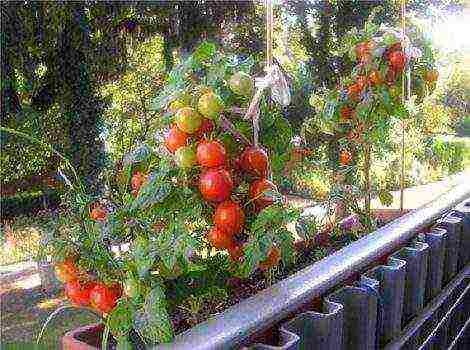Content
Before other plants, farmers began to grow:
1.rye
2. buckwheat
3.barley and wheat
4.corn
Which of the following appeared in Western Asia about 9 thousand years ago?
1.collection
2.metal processing
3. agriculture
4. cattle breeding
Why did many genera name themselves after any animal or bird, for example, "kind of Bear", "kind of Wolf", "kind of Hawk"?
1.primitive people lived in an area where there were many just such animals and birds
2.from generation to generation, a legend was passed on, according to which members of the genus had to hunt only these animals and birds
3.the relatives believed that this animal (bird) was their distant ancestor
4.the clan changed its name every year, choosing the one that was supposed to show other communities its strength and power
Which of the following items were used by artisans in their work?
1.plow
2.sickle
3.kiln for firing products
4.hoe
5.potter's wheel
6.harpoon
7.loom
8.metal smelting furnace
Establish correspondence: what came from what? Record the resulting sequence of numbers in the table.
• A) hunting
• B) production of tools, clothing, household utensils for their own needs
• B) gathering 1. craft
2. farming
3. cattle breeding
Which of the following features characterize the tribal community, and which - the neighbor's? Write down the numbers of the selected answers in the table.
1.Kinsmen chose elders - respected and wise old people
2.the head of the community was chosen by community members for wisdom and life experience
3.the elders and leaders of the tribe were nobility
4.nobility was inherited
5.all members of the community are relatives
6.Community members are neighbors
7.conversion of captives into slavery
8.property and social equality
9.property and social inequality
Arrange these events in the order in which they occurred. Record the resulting sequence of numbers in the table.
1.allocation of the nobility
2.the emergence of agriculture, cattle breeding and crafts, the transition to a settled life
3.transition to a neighborhood community
4.invention of the plow, the use of animals for plowing, the development of metals
5.the emergence of surplus products - there is no need for collective work
Option number 1
According to scientists, agriculture and metal processing appeared:
- in East Asia
- in Western Asia
- in South Africa
- in northern Europe
ANSWER: 2) in Western Asia
The first animal that man has tamed is
- sheep
- goat
- dog
- cow
ANSWER: 3) dog
Which of the listed metals was the first person to master?
- gold
- silver
- iron
- copper
ANSWER: 4) copper
Which of the listed tools appeared more than 10 thousand years ago, and which about 9 thousand years ago? Write down the numbers of the selected answers in the table.
- wooden plow
- stone ax
- copper ax
- hoe
ANSWER:
| More than 10 thousand years ago | About 9 thousand years ago |
| 1, 2, 4 | 3 |
Establish a correspondence between concepts and their definitions. Record the resulting sequence of numbers in the table.
|
|
ANSWER:
Which of the following features characterize the tribal community, and which - the neighbor's? Write down the numbers of the selected answers in the table.
- joint work of the whole community in the fields
- joint hunting
- idea of descent from a common ancestor
- common land
- community members - neighbors
- community members - relatives
- each family has its own plot of land and livestock
- each member of the community has his own tools
- community equality
- the harvest belonged to the family and was controlled by the head of the family
- common economy and harvest
- community inequality
ANSWER:
| Signs of a clan community | Signs of a neighborhood community |
| 1, 2, 3, 4, 6, 9, 11 | 5, 7, 8, 10, 12 |
Which of the following signs indicated that primitive people moved from the appropriation of the products of nature (appropriating economy) to their independent production (producing economy)? Write down the numbers of the selected answers in the table.
- clearing the soil for arable land
- domestication and domestication of wild animals
- growing new varieties of plants
- collection of wild fruits, berries, cereals (barley, wheat)
- hunting with bow and arrow for wild animals
- use of fire
- breeding new breeds of livestock
- fishing
- invention of fabric, pottery, the development of metals
- the use of animal skins as clothing
ANSWER:
| Attributes of the assigning farm: | Signs of a producing farm: |
| 4, 5, 6, 8, 10 | 1, 2, 3, 7, 9 |
Option number 2
Before other plants, farmers began to grow:
- rye
- buckwheat
- barley and wheat
- corn
ANSWER: 3) barley and wheat
Which of the following appeared in Western Asia about 9 thousand years ago?
- gathering
- metal processing
- agriculture
- cattle breeding
ANSWER: 2) metal processing
Why did many genera call themselves after any animal or bird, for example, "kind of Bear", "kind of Wolf", "kind of Hawk"?
- primitive people lived in an area where there were many just such animals and birds
- from generation to generation, a legend was passed on, according to which members of the genus had to hunt only these animals and birds
- relatives believed that this animal (bird) was their distant ancestor
- the clan changed its name every year, choosing the one that was supposed to show other communities its strength and power
ANSWER: 3)
Which of the following items were used by artisans in their work?
- plow
- sickle
- oven for firing products
- hoe
- Potter's wheel
- harpoon
- loom
- furnace for smelting metals
ANSWER: 3, 5, 7, 8
Establish correspondence: what came from what? Record the resulting sequence of numbers in the table.
|
|
ANSWER:
Which of the following features characterize the tribal community, and which - the neighbor's? Write down the numbers of the selected answers in the table.
- kinsmen chose elders - respected and wise old men
- the head of the community was chosen by community members for wisdom and life experience
- the elders and leaders of the tribe were nobility
- nobility was inherited
- all members of the community are relatives
- community members - neighbors
- enslavement of captives
- property and social equality
- property and social inequality
ANSWER:
| Signs of a clan community: | Signs of a neighborhood community: |
| 1, 2, 5, 8 | 3, 4, 6, 7, 9 |
Arrange these events in the order in which they occurred. Record the resulting sequence of numbers in the table.
- allocation of nobility
- the emergence of agriculture, cattle breeding and crafts, the transition to a settled life
- transition to a neighbor's community
- invention of the plow, the use of animals for plowing, the development of metals
- the appearance of surplus products - there is no need for collective work
ANSWER:
There were no shops in Ancient Russia, so food had to be grown by ourselves. The land in Russia has always been fertile, the main territory of the land was black soil, and it was a sin not to use it. Agriculture was discovered by women. They loosened the ground near the house with whatever fell under the hands, with sticks, bones, stones, and put the seeds of wild plants in the holes formed. Later, the plants became domesticated and fully adapted for human consumption.
By the way…
Over time, more and more territory was required for sowing, and it had to be cleared and dug up, thus men also joined in agriculture. They sowed cereals and cereals in the fields, as well as hemp and flax, which were used to make ropes and fabrics.
What was the farmer in Russia, and what was the way of his life. Types of agriculture.

In ancient Russia, a peasant farmer was very hardworking, worked tirelessly. They put on the clothes that they sewed themselves. The clothes were loose and comfortable for both work and leisure. They ate what the land gave. They ground the grain and baked the first bread. They paid tribute in grain and cloth, paid taxes.
The peasants were divided into feudal-dependent and free. Feudal dependent peasants should not be confused with slaves. Slaves were completely subordinate to the owners, and the peasants paid taxes to the feudal lords, but at the same time they had their own house, their own income, a plot of land and livestock. Initially, free farmers, commoners in Ancient Rus were called smerds, but over time they also fell into partial feudal dependence. With all this, they retained legal freedom. If the stinker took a kupa (loan) from the prince, then it passed into the category of purchases, of the lower class of peasants. The purchases were supposed to work for the feudal lord for free until they worked out their debt in full. An even lower class of peasants were called slaves. Serfs are the same as slaves who are completely dependent on the principality and do not have any rights. In 1723, servitude was abolished by Peter the Great.
Do you know what type of farming prevailed among the Eastern Slavs? The most predominant farming systems among the Eastern Slavs were called the slash-and-burn system and the fallow. Which system the farmers used depended on natural and climatic conditions. The slash-and-burn system prevailed in the north in the Taiga. It consisted in the fact that in one year trees were cut down and allowed to dry. In the second year, dry trees were burned, and grain crops were sown in this place. Ash served as a fertilizer. By the way, modern land workers also use ash as fertilizer. For several years the land gave a good harvest, but later it had to be given a rest.
Perelog was the southern farming system. The peasants could rid the plot of weeds for several years. When the land was depleted, they moved to another territory, and this area was left to "rest" for 10 years. This type of farming is also called arable farming and it was used on the territory of steppe forests.
From what territory the sowing took place depended on what the ancient farmers cultivated. In the south, buckwheat, millet, spelled, and wheat were grown. In the north, the field was sown with oats, barley, millet, winter rye and spring wheat. With the development of agriculture in Ancient Russia, they began to plant not only cereals, but also vegetables. Most of all, rutabagas, beets, carrots, potatoes, pumpkin were grown, then legumes appeared. As mentioned above, not everything that was grown was eaten. Flax and hemp were used to make fabric. All these cultures are the main agriculture of the Eastern Slavs.
Farmer of Ancient Russia
Agriculture is hard work and it is impossible without various inventions designed to help in this difficult matter. People began to create tools to help themselves. Those devices that were used in Ancient Russia have come down to us, but over time they have been modernized and improved. The quality and quantity of the future harvest directly depended on what tools were used in agriculture. The tools of labor used by ancient farmers include: plow, hoe, sickle, ax and others. Let's understand in more detail.
Farmer's tools of labor.
-

Sickle. This tool was used to harvest grain crops. Harvesting such a crop was called the harvest. Consisted of a steel, rounded like a month, a thin blade and a short wooden handle.
- Spit.The scythe is an agricultural tool for cutting grass. It has a long and sharp knife, slightly curved inward, made of steel. The handle of the braid is long, made of wood.
- Hoe. Now this tool is called a hoe. It has a long wooden handle and a paddle located perpendicular to the handle. The shoulder pad was square in shape and made of sturdy metal. It was used to chop off weeds right at the root, in other words for weeding. A pickaxe was used to work in hard ground.
- Plow. The plow was indispensable for plowing the land. The plow was used to turn the topsoil. Most often it was made of metal. Initially, the plow was pulled by the farmers themselves, later they began to use horses for this.
- Sokha. Plowing tool. The plow consisted of a thick long wooden plank with two metal teeth at the edges. The working wooden part of the plow was called rassokha, and the iron teeth were called openers. The plow was attached to the shafts into which the horse was harnessed. This tool is somewhat similar to a plow, but the plow does not turn the ground, but shifts it to the side.
- Spade. A device similar to a modern shovel in Russia was called a spade, now such a word is outdated, but the shovel continues to exist and is used in agriculture to this day. Previously, the spade was completely wooden with only a metal tip. Later, a completely iron, pointed digging part was attached to a wooden long handle, which is called a handle. This name was formed from the word to step up, step on the foot.
- Rake. The rake was and is still used today to break up clods of already plowed soil. With the help of this tool, weeds and other unnecessary items were collected from the cultivated soil, and also the mown grass was raked into one part. The Old Russian rake consisted of a wooden block, which was called a ridge. Holes were made in the ridge, into which iron teeth were inserted. A long wooden handle was attached to this base. In Ancient Russia, rakes were hand or horse-drawn, in the modern world there are rakes for a tractor. By the way, such a popular expression “to step on a rake” means to make a stupid mistake, because if you step on the ridge of a rake, you can get a handle on the forehead.
- Pitchfork. It is an agricultural tool used to collect and load hay. Also, this tool was used to puncture the soil, with the help of which its supply of oxygen was increased. The pitchfork consists of a metal piercing part, with several teeth (from three to seven pieces) and a long wooden handle. By the way, in Christian mythology, the pitchfork was considered an instrument of the Devil and devils, used to torture sinners in hell. This belief came from the images of the ancient gods, Neptune or Poseidon, which came down to the first Christians, who were perceived as the Devil, and the trident as a pitchfork. The ancient pagan Slavs did not have such associations, and the pitchfork was perceived exclusively as a tool of labor.
- Chain. A chain is two sticks connected to each other that had mobility, the first long stick was a handle, and the second short one was a thresher. Such a device was used to thresh grain or separate grains from chaff. This tool was used not only in Ancient Russia. By the way, on the basis of the flail, military melee weapons appeared - a mace or a battle flail, and the famous Japanese edged weapons - nunchucks.
- Harrow. The harrow was used in the slash-and-burn farming system, helping to avoid drying out the earth and collecting weeds. Created from wood.
Since in the era of Ancient Rus people were pagans, a huge part of their life was occupied by rituals and rituals. These traditions and agriculture were not spared. The Slavs believed that the rituals helped to appease the gods, and guaranteed them a good harvest. As a rule, rituals were performed on the days of spring holidays.
Slavic agricultural rites.
-
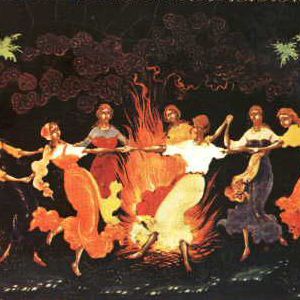
Christmas agricultural rites. In the first week of Christmastide, fasting was observed, in the second week, people wondered. Christmastide lasted from 7 to 19 January.
- Shrovetide rituals. Such ceremonies were held at the end of winter on Shrovetide from March 21, this is the day of the vernal equinox. The Slavs took the first pancake out into the yard and laid it on the ground. It was a gift to the gods Vesna and Yarila. Thanks to this, the sun warmed up the fields faster and stronger.
- Cleansing rites. It was believed that a lot of wickedness was going to gather during the winter, and it was necessary to get rid of it. First, people washed their homes and themselves, collected all the garbage and burned it in the yards, the smoke from the fires was supposed to drive away evil spirits. Then the fields were showered with ashes from these bonfires. It is not surprising that they received a good harvest from this ceremony, because ash is an excellent fertilizer. Willow branches were placed along the edges of the field, since for the ancient peasants it was a sacred plant, because the pussy willow gave its first buds earlier than other plants.
- Red hill. In the spring everything bloomed, birds flew in, the sun was shining. The first grass appeared in the fields and hills, and this created a certain contrast. Hence the name "Red Hill", red means beautiful. The crops were rolled in an egg, read conspiracies and sprinkled with bone meal. Flour was supposed to protect the future harvest from hail. The egg was buried in the field as a symbol of fertility.
- Sacrifices. The pagans considered the earth to be alive, she was their deity, and they thought that when plowing, they hurt her. Therefore, the land had to be appeased. For this, bread was inserted into the furrows, and after the end of the sowing season, they walked around the fields with food and mash and had a feast. Early spring was associated with the return of birds, so the Slavs caught the bird as a symbol of spring and ate it. It was believed that, in this way, it was best to use the forces of spring.
- Kolosyanitsa. The girls took food and walked to the birch, arranged a feast around it, sang songs, and danced in circles. They believed that birch has the power of fertility, and they wanted to use its power in the fields.
- Rites dedicated to the deities Kupala and Yarila. When the time of the harvest came, bonfires were kindled and the fields were bypassed, reading conspiracies. This was done in honor of Kupala, who was considered the god of abundance and harvest. The bonfires were designed to drive away evil spirits from the already ripe fruits. God Yarilo, was considered the god of the sun, and the sun was of great importance for the ancient Slavs and thanks to him crops grew.
- Harvest feasts of zhinka (beginning of harvest) and rezinka (end of harvest). At this time, evil spirits were driven out. They baked ceremonially bread from the first and last sheaf of the harvest. The grains were stored at home and mixed with soil during the next sowing.
In the 21st century, such rituals have become a relic of the past, and special machines are used to cultivate large areas. Nevertheless, the work of our ancestors cannot be belittled, because they gave us the beginning for the development of modern technology. And the ancient Slavic holidays are observed to this day, just for the sake of fun and as a tribute to the traditions of our history.
More Slavic rites here
Agriculture, being the most ancient type of human activity, developed rather unevenly in different countries.
What is farming?
Agriculture, which arose in the era of the primitive system, is the result of a long period of human development.
It began when people already knew how to hunt and were collecting wild fruits. Human labor began to be spent on the production of plants, on the isolation and reproduction of the most useful species, on a certain impact on them in order to adapt to their needs.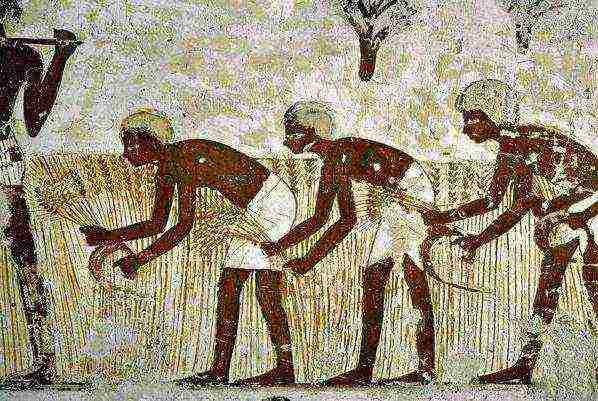
Agricultural history: origin, tools
The origin of agriculture took place a long time ago, when people noticed that various grains of fruits or ears, falling on the soil (and loose), germinate and again bear fruit. It was then that the thought came to them that in this way it is possible to grow food.Since then, they began to plant and grow the seeds of edible plants.
For sowing, the most even plots of land were selected, and those located closer to the water. People learned to loosen the land cleared of weeds with peculiar hoes, after which they threw grains into this land. It was a hoe type of farming. After the harvest was ripe, they collected it using a sickle, consisting of an arched wooden or bone base (handle), into which sharp fragments of stones were inserted.
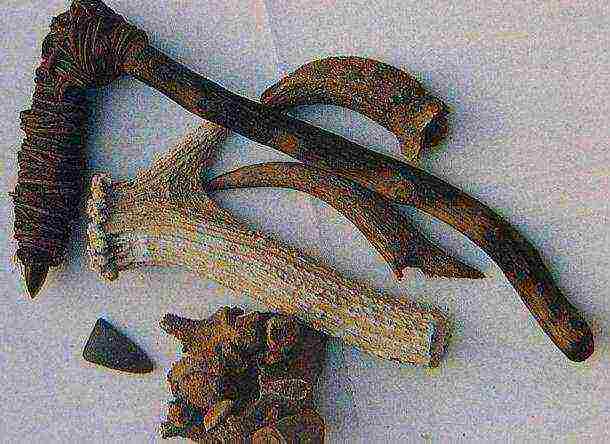
The advent of agriculture contributed to the creation of newer and more convenient tools. After a certain time, people also built a plow. At first it was just a pole with a sharp knot at its end. She simply became attached to a team of bulls. This tool could cultivate more land, and people also noticed that the yield from such a plowed field was higher than from the land cultivated with a hoe. The plow plowed the ground deeper, and the seeds planted deeper gave better germination.
First grown plants
The first plants grown by humans were barley, wheat, and millet. And their homeland is Western Asia (the peninsula of Asia Minor and the regions adjacent to it). It was in these places that the most ancient settlements of farmers were found. They were founded 10,000 years ago. Then, from these places, agriculture began to gradually spread throughout the world.
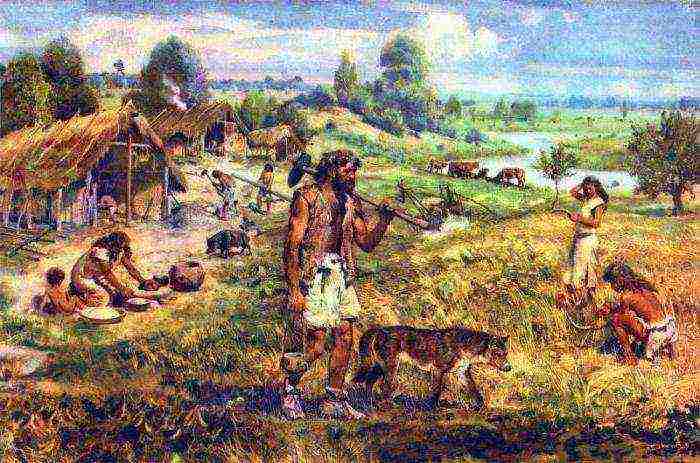
It can be concluded that such agriculture in those days, when people were already leading a more sedentary lifestyle, contributed to the emergence of new inventions, more convenient and improved tools of labor. Thanks to this process, craft began to develop - manual small-scale production of tools and various devices.
Development of agriculture by territories
A large number of archaeological and paleobotanical scientific studies indicate a connection between the origin of agriculture in antiquity with the zones of mountain plateaus and valleys in the subtropical belt. The famous scientist N.I. Vavilov identified several very ancient centers of the origin of agriculture (VII-III millennium BC):
- Near Eastern (wheat, barley, etc.).
- Mountainous and eastern valleys of China (wheat, rice, millet, etc.).
- Mexico (peppers, beans, etc.).
- Central Peru (pepper, pumpkin, cotton, beans, etc.).
What is agriculture in distant America? There it arose completely independently of other territories of the continent and is probably even more ancient.
The oldest regions in the world in terms of the development of agricultural culture in the world after Mexico: Peru, India, Bolivia, China, Egypt and Syria.
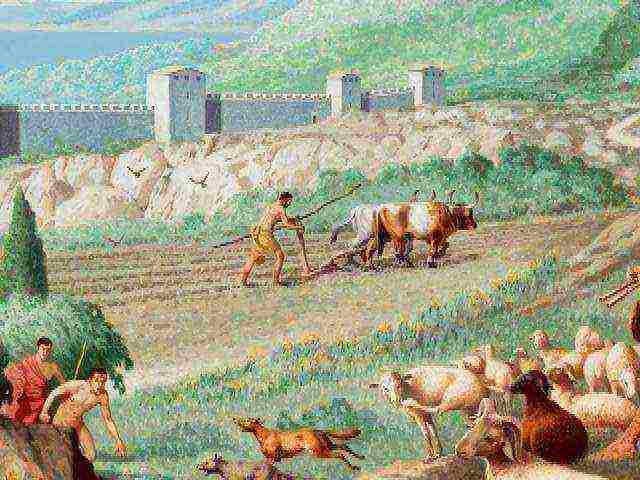
In Western Europe, the emergence of agriculture dates back to the V-IV millennia BC.
On the territory of Russia and the territories adjacent to it, agriculture arose in the Stone Age. Moreover, the most ancient centers are the regions of the entire Transcaucasia and Central Asia.
Conclusion
Having dealt with the question of what agriculture is, we can conclude: having mastered this type of activity and animal husbandry, mankind gradually moved from appropriating (as it was in ancient times) farming to producing - the process of improving the tools for labor went faster. And this contributed to the emergence of the craft.
